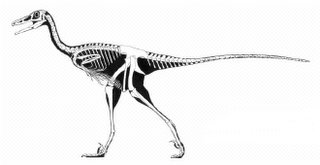Basement find has scientists going snap Crocosaur? ... the skeleton of an early reptile shows evolutionary similarites between crocodiles and dinosaurs.
Photo: ReutersJanuary 27, 2006
Scientists have discovered a fossil in New Mexico that looks like a two-metre-long, two-legged dinosaur along the lines of a tyrannosaur or a velociraptor. But it is actually an ancient relative of today's crocodiles and alligators.
The discovery is a striking example of how different animals can evolve the same kind of body over and over again.
For almost 60 years, the 210-million-year-old fossil has been hiding in plain sight, in the basement of New York's American Museum of Natural History. It was in a slab of rock dug up in 1947 in New Mexico.
Now whats interesting is that this crocidile walked upright on two feet, bipedal. It occured at the end of the crocidile species dominance on the earth prior to the rise of the dinosaurs. Hey I didn't know that crocs are older than dinos.
Anyways like later developments, bipedalism appears to be an evolutionary stream that occurs in later species development, now I won't say more advanced, as that may not be the case, but in later development.
Whether that would lead to expanded brain activity and the evolution of the species into a hominid like with higher intelligence, has been speculated on. And the similarity between this croc and the species Troodon (Stenonychosaurus unequalis) which was creature speculated upon are quite startling.

But it is not nessacary to speculate, to once again be awed by what evolution shows us. Bipedalism is a late development of species.
Dino-Era Fossil Reveals Two-Footed Croc RelativeCroc Decline Key to Dino Rise?
Modern crocodiles are but one remnant of what was once a far more diverse croc family.
"Today we think of crocodiles as looking basically the same," said Nesbitt, of the American Museum of Natural History and Columbia University's Lamont-Doherty Earth Observatory. "But in their history they took on a wide variety of different body plans."
"Some looked like reptilian armadillos or cats, and others looked like little dinosaurs," Nesbitt said.
The crocodilian family may have been at its peak during the Triassic period.
"Toward the end of the Triassic period you have this crazy diversification of these crocodile relatives, including this animal," Nesbitt said.
"It was really the heyday of the crocodile-like animals, but the only lineage to really make it out of the Triassic was the lineage that led to modern crocodiles."
Nesbitt explains that dinosaur evolution was likely in its infancy during this period.
"We're not 100 percent sure what the story is," he cautioned.
"Now it seems that dinosaurs were there with these animals, they were part of the fauna. But they remained pretty small and not very diverse.
"We don't see the typical museum type dinosaurs until the Jurassic. Nothing is really happening [in dinosaur evolution] until after these crocodile relatives are gone," Nesbitt added.
It may be that Effigia-like animals were widespread but dinosaurs were comparatively rare during this era, Norell, the museum curator, explained.
If so, dinosaur evolution might have blossomed only after most crocodile-like animals became extinct. Those extinctions might have left an attractive environmental niche for the dinosaurs.
The theory seems to be backed by the abundance of Effigia-like animals found from North America's late Triassic period.
Many fossils once thought to be dinosaurs turn out, on closer inspection, to be crocodile-like animals that, like Effigia, only look like dinosaurs.
Many of these croc-like animals "are difficult to identify without nearly complete specimens, especially skulls," Nesbitt said. "If you just have a vertebra, for example, you can't tell them apart."
For more stories on dinosaurs and cryptozoology see my Live Journal Heresiology
Tags
science
dinosaur
crocidile
bipedal
evolution
palentology
No comments:
Post a Comment